We are going backwards as a culture!” That’s something you’ve probably heard a Baby Boomer say in the past few years. Claims such as these have been circulating, and I can’t help but agree that we are, in many ways, regressing as a society. Our social skills, critical thinking, dietary habits and physical fitness have all seemingly taken a turn for the worse over the past thirty or so years with the rise of the Internet and modern technology. We have become reliant on cell phones to communicate with others, store our information and think for us. So, as people, it’s arguable that we have “downgraded.” If there is a problem, though, there must also be a solution. After observing several trends in the past few years, I have come to a conclusion: To stop our downgrade, we must downgrade.
As I said, it seems that our reliance on phones has impacted our cognitive capabilities, independence and lifestyle maintenance. The easiest assumption to come to is that our phones are the problem. However, it’s easier said than done to get rid of this problem, because we do need our phones. Unless you are planning on going completely off of the grid, it is virtually
(pun intended) impossible to not have a cell phone. They are what we use to schedule appointments, make plans with friends, check the weather, read the latest news and even to pay for items at the store. In order to be a functioning member of society, it is almost required that you have a smartphone or computer. Notice that I mentioned how we do almost everything on them— because really, they can do almost anything. They can take pictures. They can stream music and movies. They can count your steps.
But do we need them to do that? Cell phones started out as simply a way to communicate on the go. Over time, they have evolved to be much more than that. But we don’t have to let them. Enter an idea called “digital minimalism.” In essence, the concept is that we should prioritize our cellphone media consumption to become as little as possible. When we are forced to choose which things are most important to us, we are filtering out a lot of the clutter. For example, that could mean choosing between the newest Film Theory YouTube video or re-watching “Gilmore Girls” for the seventh time.
In actuality, these things are basically mindless media consumption, and in a perfect world, we wouldn’t be spending our time on any of these things. However, it’s fun to watch and see what Lorelai will do next, and it’s comforting to watch a YouTuber that you have been subscribed to since you were nine. It’s unfair to expect ourselves to entirely cut out something that has become an integral part of our identity. A much more realistic goal is to cut down your screen time by 50 percent over the course of the next six months.
It’s a challenge, but it isn’t impossible. And I promise, you will feel like you have more time than ever before. In addition to this basic “spring cleaning” of what media that we consume on our phones, there is another easier (and significantly more fun) way to cut our screen time. That’s by cutting the number of functions that we perform with our phone. For example, digital cameras have become very popular in the last few months. I liked the aesthetic, and I had an Amazon gift card, so I decided to hop on the trend and buy my very own dinky little camera. After buying the camera, I noticed something: When I wanted to take a picture, my first instinct was no longer to pull out my phone, but to take out my little pink camera — and after snapping a photo, I could simply put the camera back in its pouch to look at later, rather than stopping what I was doing to examine every picture.
Beyond cameras, there are plenty of other small changes that we can make to minimize our phone dependency: For example, use an MP3 rather than Spotify on your runs. When you’re making plans with friends, pull out a physical planner instead of your calendar app. When you want to make a fun recipe, find the family cookbook instead of a mommy-blogger post. The possibilities are endless here.
It may sound outlandish to reject phones and further inconvenience our own lives. Sure, it’s more stuff to carry around. Sure, it’s slower, and sure, it may not be as high-tech. That’s the point, though. Phones are very clearly something that has become addictive to our generation, and it’s a serious problem. Beyond that, though, there is proof that we have a natural interest towards simpler, “vintage” versions of modern commodities. For example, as I write this, I sit on my bed, surrounded by grandma-themed decor (house-shaped teapots, small figurines and more books than I know what to do with,) watching “Gilmore Girls” and wearing my mom’s t-shirt from 2006. To a differing extent, we all have a natural inclination to embrace the old, because, in my opinion, it’s closer to what we perceive as natural.
I’ll be the first to admit that I have a higher screen time than I am proud of. I use my phone too much, I sit around during the day and I depend on technology to find any and all information that I may need.
It doesn’t have to remain that way, though. It’s undeniable that phones are, in some ways, detrimental: They’re addictive, decrease our physical activity and provide us with networks to spread negativity and bullying. Letting go of something that has become central in our lives is difficult, if not impossible. That’s not what I am suggesting that we should do. However, it’s clear that changes have to be made, and small steps like buying a notebook and finding your dad’s old digital camera can be the first step to reclaiming your independence.
So, whether you’re a proud phone addict or an ashamed midnight scroller, it’s time to admit that changes can be made, and that those changes are probably a good thing.



